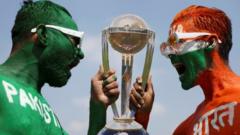Roaring crowds adorned in blue and green cheer their teams as the cricket world tunes in for the latest chapter in the saga of India and Pakistan, a rivalry that is as much about cultural identity as it is about sportsmanship. Recent discussions around the rivalry have been ignited by a Netflix documentary titled "The Greatest Rivalry: India v Pakistan," which gives viewers a glimpse into the emotional and historical tapestry woven into this contest.
Cricket legends from both countries weigh in, with India’s Virender Sehwag stating, "This is a contest bigger than one between the bat and ball,” while Waqar Younis from Pakistan affirms it ranks "right at the top," amidst fierce instincts fueled by years of socio-political strife. R. Ashwin argues that this rivalry surpasses the renowned Ashes series, suggesting that the political drama surrounding the matches adds a layer to their significance.
Yet the recent performances have raised eyebrows. India's cricket team has consistently outplayed Pakistan, having secured six victories in the last eight encounters. The last time Pakistan triumphed was in 2017 during the Champions Trophy final, a fading echo in a growingly skewed rivalry. The gap between the two teams’ performances leads some critics to question the rivalry's authenticity, inferring that political tensions may be the only thread maintaining its vitality.
Pakistan-based Dawn newspaper raised the query: what rivalry exists when one team is overwhelmingly dominant? The media's narrative shifts, with India's recent victory termed by India Today as ushering Pakistan cricket into "pity territory." The questions are stark: Has the thrill diminished? Do the players reflect the “war minus the shooting” sentiment that George Orwell once dissected?
The challenges within Pakistan's cricket setup are well-documented, as they face internal woes of politics, coaching fiascos, and an inability to climb out of the isolation stemming from global cricketing impositions. In contrast, India's cricketing ascendancy continues, bolstered by a robust domestic structure and the allure of the IPL.
Insights from Pakistani cricket writers highlight a lingering sense of marginalization as Pakistani players find themselves excluded from leagues like the IPL, witnessing their Indian counterparts thrive in unmatched platforms. This growing divide emphasizes the necessity for revival on Pakistan’s front.
Amidst decreasing competitiveness, marketing entities continue to amplify the rivalry, increasingly transforming it into a financial juggernaut rather than a pure sporting competition. Yet, despite concerns over the quality of cricket, the enthralled fan base remains hungry for more, with sold-out matches recording astonishing viewership numbers even in a crowded media landscape.
As the debate persists on whether this iconic rivalry has lost its luster, India's vice-captain Shubman Gill maintains, "It is an exciting contest," emphasizing the joy it brings to fans. Ultimately, despite the complexities of performance and narrative, cricket's enduring bond and the stakes tied to these matches still electrify audiences, as highlighted by the ongoing excitement for these monumental clashes. The question remains: as the rivalry evolves, what does the future hold for India and Pakistan on the cricket field?






















